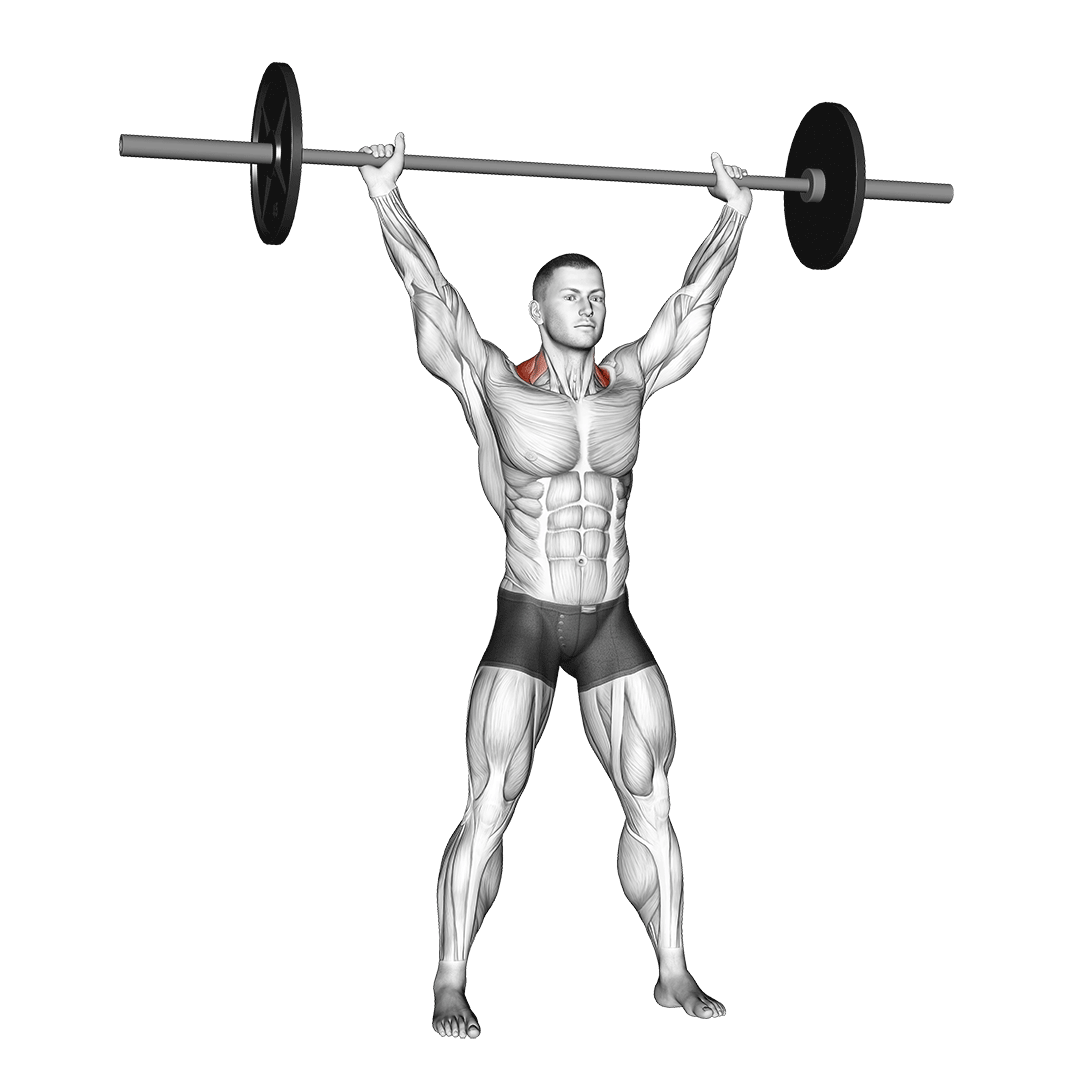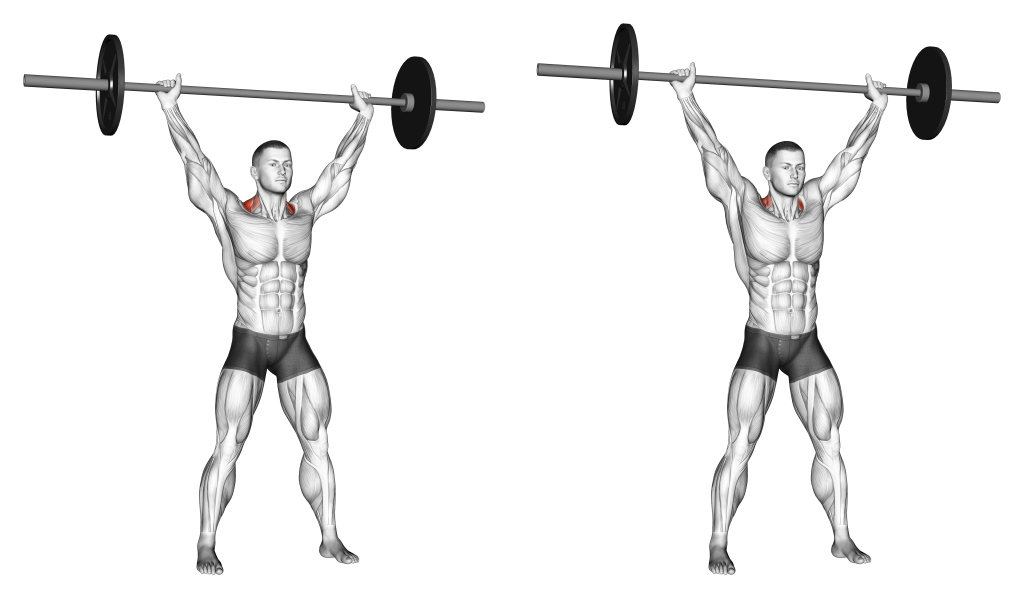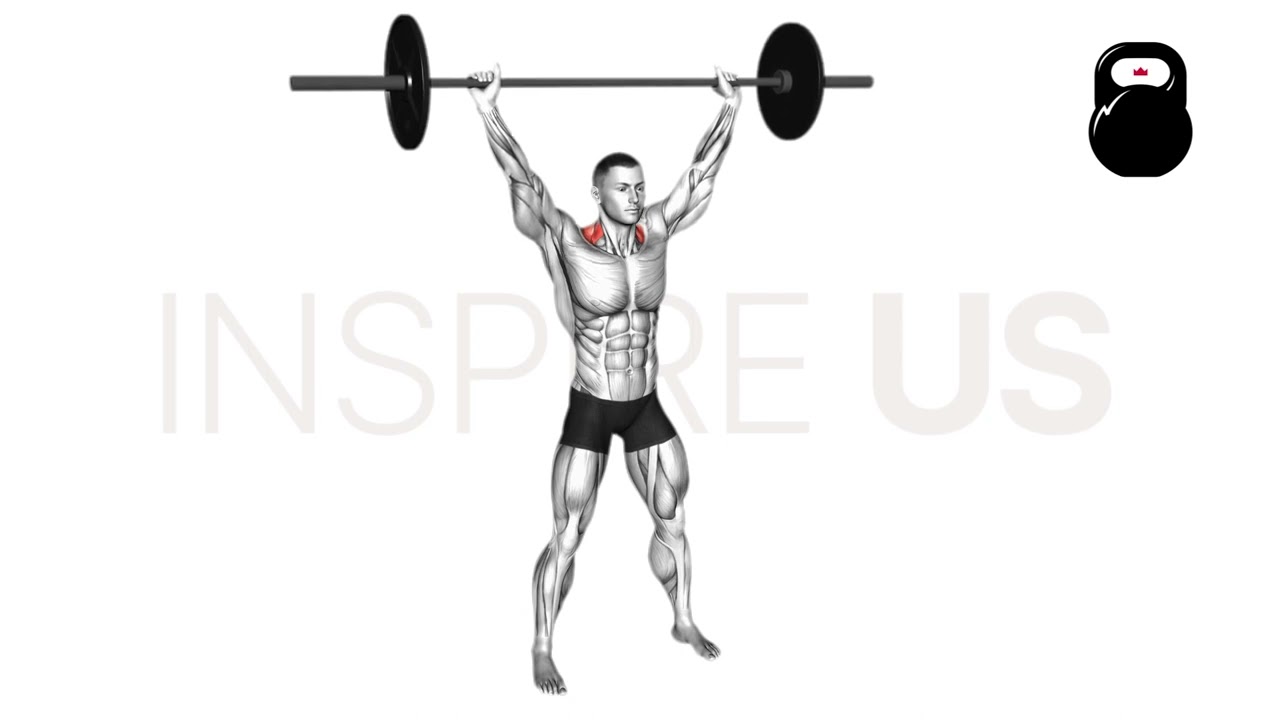Overhead Shrugs Exercise Overview: Muscles Worked and More
The overhead shrug is a free weight trapezius isolation exercise purposed for the development of strength and mass throughout the entire shoulder girdle.
The movement may be further weighted by having the lifter grip a barbell or pair of dumbbells as they do so.
Occasionally, it is also used as a tool for correcting a habitually depressed scapula or similar issues related to upper back posture.
Overhead Shrug at a Glance
Equipment Requirements
None or Free Weights (Optional)
Main Muscles Targeted
Upper Trapezius
Difficulty
Moderate
Sets, Reps, and Load Recommendations
2-4 Sets of 10-16 Repetitions at a Light or Moderate Load
How to Do Overhead Shrugs
- To perform a repetition of the overhead shrug, the lifter will begin by standing upright with their core braced and their glutes squeezed so as to create a stable base for the body.
- Now positioned correctly, the lifter will raise their arms straight upwards, locking the elbows out and positioning the hands slightly wider than shoulder-width apart.
If performing the exercise weighted, the hands should be in a pronated grip spaced wider than the shoulders. - Arms now held overhead, the lifter elevates their scapula and raises their shoulders upwards and outwards - as if trying to bring their deltoids parallel to their ears. The neck should remain aligned with the trunk, the head facing forwards and the arms completely extended.
- Once the limits of their trapezius ROM have been reached, the lifter then slowly lowers their shoulders and scapula back to a neutral position.
- The repetition is now considered to be complete. Further repetitions do not need the arms to be raised overhead each time - instead, they should be held in place throughout the set.
Additional Tips:
The overhead shrug’s safety as an exercise is largely predicated by the position of the humerus within the shoulder joint.
An excessively narrow arm position may increase strain on the rotator cuff and the ball-and-socket joint of the shoulder itself - especially when using a barbell for loading. Aim for wider than shoulder-width.
A good cue to ensure the scapula is being fully elevated is watching the position of the latissimus dorsi in the mirror. If the scapula is elevated and the trapezius is engaged, the lats will seem to “tuck” behind the body, rather than flare outwards.
Sets and Reps Recommendation:
Outside of advanced Olympic weightlifting training, there is no reason to perform the overhead shrug with a significant amount of weight. Lifters should rely on volume and time under tension to drive the intensity of the set.
As such, somewhere between 2-4 sets of 10-16 repetitions would be ideal - especially if using a light or moderate load.
What Muscles do Overhead Shrugs Work?
The overhead shrug is considered to be an isolation exercise as its main purpose is to target the upper section of the trapezius muscles.

Despite this, the entirety of the deltoids will nonetheless be contracted in an isometric capacity, as they will stabilize the arms alongside whatever weight is being lifted.
Common Overhead Shrug Mistakes to Avoid
For optimal development of the upper trapezius, avoid the following common mistakes.
Otherwise, if performing the overhead shrug for rehabilitative purposes, remember to follow the advice of your physical therapist.
Failing to Engage Scapula
As the entire function of the overhead shrug is to recruit the trapezius and engage the scapula, failing to properly utilize it may defeat the entire purpose of the movement.
There should be a visible shrugging upwards of the shoulders with each repetition, often with the latissimus dorsi retracting alongside.
Another good cue is to ensure the arms themselves are stationary as the shrugging movement occurs. Extension of the lower back, bending of the elbows or any movement other than that of the scapula may indicate that it is not being utilized in the exercise.
Excessive Lumbar Extension
Although unlikely to affect the shoulders or trapezius, allowing the lower back to hyperextend or the pelvis to tilt anteriorly may strain the lumbar or thoracic section of spine.
What’s more - such a curvature provides a poor base for stability, needlessly increasing risk of injury and fatiguing the deltoids.
In order to avoid hyperextending the lower back, the lifter should squeeze their glutes so that the pelvis is pushed forwards as the core remains tightly activated. This will straighten the lower body and greatly enhance stability.
Forward Neck Extension
Lifters may occasionally make the mistake of extending their neck forwards as they elevate the scapula. This can increase strain along the cervical section of the spine while also leading to a number of issues related to upper back positioning.
Throughout the entire overhead shrug set, the neck should be aligned over the trunk, the chin partially tucked in and the eyes fixed forwards.
Apart from reducing strain, maintaining the position of the neck will help maximize trapezius range of motion and ensure no unconscious rotation of the trunk occurs.
Overhead Pressing the Weight
As is clued in by its name, the overhead shrug’s primary mechanic is shrugging of the shoulders.

Performing an overhead press by rotating the shoulders out of a neutral position - or by bending and extending the elbows - will shift emphasis away from the trapezius and potentially lead to impingement of the shoulders.
The elbows should remain fully extended throughout the set, whereas the shoulders themselves should remain within a neutral range of rotation, rather than rolled internally. Keeping the chest pushed out and the neck properly aligned can help maintain said positioning.
Who Should Do Overhead Shrugs?
Overhead shrugs are generally accessible to the majority of lifters, but truly shine for sufferers of low shoulder positioning or strength athletes who frequently perform overhead movements.
In both cases, the trapezius-strengthening and scapular-correcting benefits of the overhead shrug are most useful.
However, those with a history of rotator cuff, shoulder joint or elbow issues may wish to first speak to a medical professional prior to attempting the overhead shrug.
The movement can aggravate sensitive areas - especially those relating to impingement of the shoulder joint.
References
1. Suchomel, Timothy J. PhD, CSCS*D1; Comfort, Paul PhD, CSCS*D2; Lake, Jason P. PhD3. Enhancing the Force-Velocity Profile of Athletes Using Weightlifting Derivatives. Strength and Conditioning Journal 39(1):p 10-20, February 2017. | DOI: 10.1519/SSC.0000000000000275

